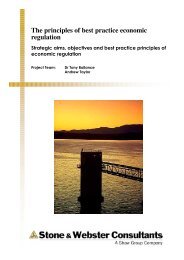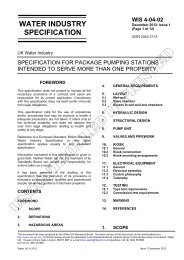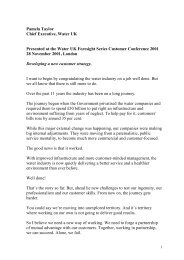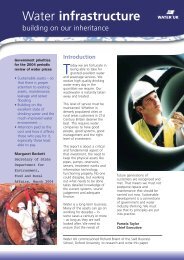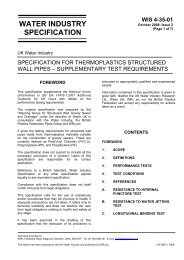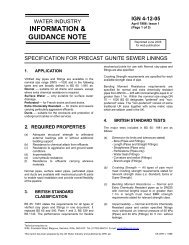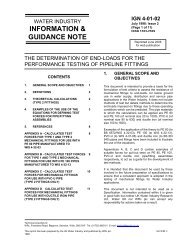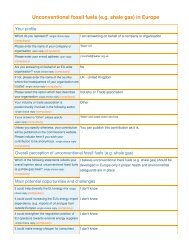Assessing potential changes in retail costs 2015-2020 - Water UK
Assessing potential changes in retail costs 2015-2020 - Water UK
Assessing potential changes in retail costs 2015-2020 - Water UK
Create successful ePaper yourself
Turn your PDF publications into a flip-book with our unique Google optimized e-Paper software.
First Economics—––—–—–—–—–—–—–—–—–—–—–—–—–—–—–—–—–—–—–—–—–———–—–—–—–—–—–4. Forecast Cost EscalationOfwat’s focus <strong>in</strong> PR14 is on the <strong>costs</strong> that companies will <strong>in</strong>cur <strong>in</strong> the period <strong>2015</strong>-20 and notthe cost pressures that have been felt historically. We look <strong>in</strong> this section at what theexpected rate of cost escalation might be for these five years us<strong>in</strong>g the methodology appliedby Ofwat and the Competition Commission <strong>in</strong> PR09 and the subsequent 2010 Bristol <strong>Water</strong><strong>in</strong>quiry, i.e.:Frontier shift ≈ <strong>in</strong>put price <strong>in</strong>flation m<strong>in</strong>usproductivity improvement4.1 The <strong>in</strong>put mixThe first step <strong>in</strong> the analysis <strong>in</strong>volves obta<strong>in</strong><strong>in</strong>g a breakdown of the different <strong>in</strong>puts thatcompanies use when provid<strong>in</strong>g <strong>retail</strong> services. To get this understand<strong>in</strong>g, we put an<strong>in</strong>formation request to a sample of companies at the start of this project to establish whatthese <strong>in</strong>puts are and what weights they have. The outputs of this work are shown <strong>in</strong> table 4.1Table 4.1: Input mix for a representative water companyInput % of household <strong>retail</strong> <strong>costs</strong> % of non-household <strong>retail</strong><strong>costs</strong>LabourBus<strong>in</strong>ess ITDoubtful debtMaterials/Postage/Premises/Vehicles/Other4510351055102510The analysis <strong>in</strong>dicated that labour <strong>costs</strong> are the biggest s<strong>in</strong>gle component of <strong>retail</strong> <strong>costs</strong>,followed closely by bad debt. The only other significant category of <strong>costs</strong> that all of thecompanies we surveyed brought to our attention is IT. Individual companies then variouslyflagged materials, postage, premises and vehicles <strong>costs</strong> to us as non-trivial contributors to<strong>costs</strong>, but not with any great consistency.Compar<strong>in</strong>g household and non-household <strong>costs</strong>, it is apparent that doubtful debt constitutesa higher percentage of household <strong>retail</strong> <strong>costs</strong>. Partly as a consequence of this, a higherpercentage of non-household <strong>retail</strong> <strong>costs</strong> can be attributed to labour.4.2 Input price <strong>in</strong>flationBased on the <strong>in</strong>put mix <strong>in</strong> table 4.1, we now give our estimate of the exogenous <strong>in</strong>put price<strong>in</strong>flation that will confront an efficient <strong>retail</strong>er over the period to March <strong>2020</strong>. We do this bymak<strong>in</strong>g estimates of <strong>in</strong>put price <strong>in</strong>flation affect<strong>in</strong>g each <strong>in</strong>put <strong>in</strong> turn.4.2.1 Macroeconomic outlookThese forecasts need to be anchored to the overall macroeconomic outlook for the <strong>UK</strong> <strong>in</strong> theyears covered by this study.In previous First Economics reports we have relied on HM Treasury and Bank of Englandprojections of GDP growth. The HM Treasury’s forecasts are now produced by the9
First Economics—––—–—–—–—–—–—–—–—–—–—–—–—–—–—–—–—–—–—–—–—–———–—–—–—–—–—–<strong>in</strong>dependent Office of Budget Responsibility (OBR), which <strong>in</strong> our view strengthens the casefor us<strong>in</strong>g public-sector numbers as the anchor for our calculations. 2Table 4.2 and figure 4.3 reproduce figures that may be found <strong>in</strong> the OBR’s March 2013economic forecast and the Bank of England’s February 2013 Inflation Report.Table 4.2: OBR’s March 2013 forecasts of GDP growthSource: OBR.Figure 4.3: The Bank of England’s February 2013 forecast of GDP growthSource: Bank of England.The two sets of numbers tell a fairly consistent story about the path which the <strong>UK</strong> economyis projected to follow, albeit with the Bank of England pa<strong>in</strong>t<strong>in</strong>g a slightly more pessimisticpicture than the OBR. In both cases, there is a year of disappo<strong>in</strong>t<strong>in</strong>g growth dur<strong>in</strong>g 2013 as2 The alternative of us<strong>in</strong>g a s<strong>in</strong>gle private-sector provider of economic forecasts presents a number ofdangers. For one, it could be that the selected forecaster takes a view of future economic prospectsthat sits outside of ma<strong>in</strong>stream consensus. This might give an <strong>in</strong>appropriately extreme picture of theprice <strong>in</strong>flation that is likely to impact on companies. It could also be that stakeholders come <strong>in</strong> future toshop around for forecasts that further their <strong>in</strong>terests – i.e. very high price <strong>in</strong>flation for companies, verylow price <strong>in</strong>flation for customers. We do not th<strong>in</strong>k that this would be a positive development.10
First Economics—––—–—–—–—–—–—–—–—–—–—–—–—–—–—–—–—–—–—–—–—–———–—–—–—–—–—–households cont<strong>in</strong>ue to grapple with shr<strong>in</strong>k<strong>in</strong>g real <strong>in</strong>comes, exporters struggle with sluggishexternal demand and the government re<strong>in</strong>s back its spend<strong>in</strong>g. Thereafter the recoverygathers pace through 2014 and starts to exhibit growth of 2% to 3% per annum from mid-2014 onwards.The Bank of England helpfully identifies the key uncerta<strong>in</strong>ties around the central case. Thema<strong>in</strong> downside risk is around the challenges with<strong>in</strong> the eurozone, but there are alsocont<strong>in</strong>ued concerns about the erosion of household <strong>in</strong>comes by <strong>in</strong>flation. Balanced aga<strong>in</strong>stthis on the upside, the Bank is positive about the growth of credit and notes that either aslowdown <strong>in</strong> <strong>in</strong>flation or <strong>in</strong>creased productivity growth would help boost wages and supporthousehold consumption. It is also possible that fears about the eurozone economies havebeen exaggerated. Figure 4.3 shows a balanced set of risks around the central case, withthe downside probabilities no greater than the upside probabilities <strong>in</strong> the Bank’s estimation.As far as the global economy is concerned, the figures <strong>in</strong> table 4.2 show a cont<strong>in</strong>ued dip <strong>in</strong>world GDP growth <strong>in</strong> 2013 as the effects of the eurozone recession and weak growth <strong>in</strong> theUS affect export-oriented economies around the world. However, the scale of this slowdownis not to be overstated and there is a return to very strong global growth from 2014 onwards.Looked at side-by-side, the implication of these forecasts is that <strong>in</strong>flationary pressures will beweak generally for the next 12-18 months before strong global growth and the much-delayedrecovery of the <strong>UK</strong> economy put new pressures on prices. We now consider to what extentthis is apparent <strong>in</strong> recent data and what the prognosis is for the 2013/14 to 2019/20 period.2.1.2 Detailed <strong>in</strong>put-by-<strong>in</strong>put forecastsWagesFigure 4.4 plots the historical rate of change <strong>in</strong> the ONS’ private sector average weekly wage<strong>in</strong>dices.Figure 4.4: Private sector wage <strong>in</strong>flationSource: ONS.11
First Economics—––—–—–—–—–—–—–—–—–—–—–—–—–—–—–—–—–—–—–—–—–———–—–—–—–—–—–The chart shows a marked shift <strong>in</strong> exogenous wage pressures due to recession. Aftergrow<strong>in</strong>g at an average annual rate of just over 4% on both measures between 2000 and2008, wages decl<strong>in</strong>ed <strong>in</strong> absolute terms <strong>in</strong> 2009, after account<strong>in</strong>g for the effects of withdrawnbonuses, and then grew by only 1.5% to 2.5% <strong>in</strong> 2010, 2011 and 2012. The latest monthlydata from February 2013 shows a further weaken<strong>in</strong>g <strong>in</strong> wage pressures, with annual privatesectorwage growth at 0.8% <strong>in</strong>clud<strong>in</strong>g bonuses and 0.6% exclud<strong>in</strong>g bonuses.Go<strong>in</strong>g forward the expectation is one of subdued wage growth stretch<strong>in</strong>g over a period of upto 3 years. This is based to a large extent on historical experience which shows that pay<strong>in</strong>creases typically lag beh<strong>in</strong>d the growth <strong>in</strong> GDP by several quarters, ma<strong>in</strong>ly becauserecession creates a pool of unemployed workers who compete vigorously for jobs onceeconomic activity picks up and firms resume hir<strong>in</strong>g. Although this recession resulted <strong>in</strong> fewerredundancies than previous recessions, there are still around 1m more <strong>in</strong>dividuals thannormal <strong>in</strong> unemployment and many more who have been forced onto part-time hours or <strong>in</strong>tojobs that they might not otherwise have taken. This should mean that employers, <strong>in</strong>clud<strong>in</strong>gthe water and sewerage companies, will for a period f<strong>in</strong>d that they do not need to offersignificant pay <strong>in</strong>creases <strong>in</strong> order to attract and reta<strong>in</strong> good staff.The OBR’s March 2013 forecast gives a sense of what sort of market-driven pay <strong>in</strong>creasesfirms should expect to have to pay dur<strong>in</strong>g the next five years.Table 4.5: Labour market forecastsSource: OBR.The projections have average earn<strong>in</strong>gs growth dropp<strong>in</strong>g slightly <strong>in</strong> 2013 before accelerat<strong>in</strong>ggradually to 4.0% by the end of the forecast period. We use the f<strong>in</strong>ancial year equivalents asthe best available estimates of the wage <strong>in</strong>flation for workers employed by a <strong>retail</strong> bus<strong>in</strong>ess<strong>in</strong> the period to 2017/18, as set out <strong>in</strong> table 4.6 below. From 2018/19 onwards we th<strong>in</strong>k it isprudent to allow for pay <strong>in</strong>creases <strong>in</strong> l<strong>in</strong>e with the pre-recession growth of average weeklyearn<strong>in</strong>gs <strong>in</strong>clud<strong>in</strong>g bonuses of 4.25% per annum.Table 4.6: General wage <strong>in</strong>flationAverage earn<strong>in</strong>gs growth2013/142014/15<strong>2015</strong>/162016/172017/182018/19 and thereafter1.8%2.9%3.8%4.0%4.0%4.25%12
First Economics—––—–—–—–—–—–—–—–—–—–—–—–—–—–—–—–—–—–—–—–—–———–—–—–—–—–—–Bus<strong>in</strong>ess ITThe prices of IT products and services are notoriously difficult to track on a consistent, likefor-likebasis. After suspend<strong>in</strong>g the publication of its corporate IT price <strong>in</strong>dices <strong>in</strong> 1999, theONS launched a new data series <strong>in</strong> 2005 as part of its experimental service producer price<strong>in</strong>dex. Figure 4.7 plots the data.Figure 4.7: Bus<strong>in</strong>ess IT cost <strong>in</strong>creasesSource: ONS.Our read<strong>in</strong>g of this chart is that bus<strong>in</strong>ess IT <strong>costs</strong> are not as unpredictable as wage <strong>costs</strong>.Historical read<strong>in</strong>gs of the annual rate of change <strong>in</strong> the <strong>in</strong>dex have been with<strong>in</strong> a fairly narrow-0.5% to +2% range.Go<strong>in</strong>g forward, it would seem prudent to provide for a flat annual price <strong>in</strong>flation allowance atthe mid-po<strong>in</strong>t of this range. We therefore provide for price <strong>in</strong>creases of 0.75% per annum.Table 4.8: Bus<strong>in</strong>ess IT cost <strong>in</strong>flationIT cost <strong>in</strong>creases2013/14 and thereafter 0.75%Doubtful debtIt is difficult to be precise about the rate of <strong>in</strong>crease <strong>in</strong> bad debt dur<strong>in</strong>g the <strong>2015</strong>-20 periodgiven that a key driver of the size of companies’ bad debts is the size of customers’ bills, thevalues of which will not be known for another 18 months. A very simple assumption for thepurposes of this analysis only might be that bad debt will <strong>in</strong>crease on average by around therate of RPI <strong>in</strong>flation (as the <strong>in</strong>dex for roll<strong>in</strong>g forward wholesale price limits). We note that thiswould mirror the assumption that Ofwat and the Competition Commission made <strong>in</strong> 2010, butprovide for lower cost <strong>in</strong>creases than have been seen <strong>in</strong> recent years (see figure 3.2).13
First Economics—––—–—–—–—–—–—–—–—–—–—–—–—–—–—–—–—–—–—–—–—–———–—–—–—–—–—–Figure 4.11: Materials (mach<strong>in</strong>ery and equipment) cost <strong>in</strong>creasesSource: ONS, PPI.Figure 4.12: Rent <strong>in</strong>creasesSource: ONS, SPPI.15
First Economics—––—–—–—–—–—–—–—–—–—–—–—–—–—–—–—–—–—–—–—–—–———–—–—–—–—–—–Figure 4.13: Postage cost <strong>in</strong>creasesSource: ONS, RPI.Figure 4.14: Motor<strong>in</strong>g cost <strong>in</strong>creasesSource: ONS, RPI.16
First Economics—––—–—–—–—–—–—–—–—–—–—–—–—–—–—–—–—–—–—–—–—–———–—–—–—–—–—–When look<strong>in</strong>g forward to March <strong>2020</strong>, it is relevant to note that:• commercial rents tend to be correlated over the long term to residential house prices,which <strong>in</strong> turn tend to be correlated to average earn<strong>in</strong>gs growth;• Ofcom has recently imposed a new control on the cost of second class postage, whichcaps annual price <strong>in</strong>creases to CPI; and• the cost of runn<strong>in</strong>g vehicles will be heavily dependent on global oil prices.Rather than make <strong>in</strong>dividual forecasts of all the items <strong>in</strong> the ‘other’ category, we make a verybroad brush assumption that <strong>costs</strong> will <strong>in</strong>crease by 2% per annum. At a very high level, andrecognis<strong>in</strong>g the relatively small weight attributable to specific cost items, this looks to be areasonable extrapolation of historical experience, as moderated by the considerations setout above.Table 4.15: Other cost <strong>in</strong>flationOther cost <strong>in</strong>creases2013/14 and thereafter 2%SummaryTable 4.16 pulls the l<strong>in</strong>e-by-l<strong>in</strong>e forecasts <strong>in</strong>to an overall estimate of the <strong>in</strong>put price <strong>in</strong>flationoutside of management control affect<strong>in</strong>g household and non-household <strong>retail</strong> services.Table 4.16: Aggregate <strong>in</strong>put price <strong>in</strong>flation2013/14 2014/15 <strong>2015</strong>/16 2016/17 2017/18 2018/19andthereafterLabour1.82.93.84.04.04.25Bus<strong>in</strong>ess IT0.750.750.750.750.750.75Doubtful debt3.12.93.33.74.03.4Other2.02.02.02.02.02.0Input price <strong>in</strong>flation(household)Input price <strong>in</strong>flation(non-household)2.2 2.6 3.1 3.4 3.5 3.42.0 2.6 3.2 3.4 3.5 3.54.2 Productivity growthThe extent to which productivity growth can be expected to offset the above <strong>in</strong>put pricepressures depends on a number of factors, <strong>in</strong>clud<strong>in</strong>g:• the pace of technical progress;• the availability of opportunities to reduce overheads; and• companies’ ability to br<strong>in</strong>g better work<strong>in</strong>g practices to bear on its activities.A useful reference po<strong>in</strong>t for understand<strong>in</strong>g the productivity growth <strong>potential</strong> of a bus<strong>in</strong>ess ishistorical total factor productivity (TFP) improvement achieved by competitive sectors of the<strong>UK</strong> economy which are <strong>in</strong> some way similar to a <strong>retail</strong> bus<strong>in</strong>ess The most up-to-date sourcefor this type of data is the EU KLEMS project which looked at economic growth, productivityand technological change for all European Union member states dur<strong>in</strong>g the period 1970 to17
First Economics—––—–—–—–—–—–—–—–—–—–—–—–—–—–—–—–—–—–—–—–—–———–—–—–—–—–—–2007. A database released to the public <strong>in</strong> 2008 and updated <strong>in</strong> 2010 allows researchers toanalyse TFP growth on an <strong>in</strong>dustry-by-<strong>in</strong>dustry basis and to compare/benchmark thehistorical performance of <strong>UK</strong> companies aga<strong>in</strong>st firms from elsewhere.The EU KLEMS database conta<strong>in</strong>s <strong>in</strong>formation for 38 sectors, sub-sectors and sub-subsectorsof the <strong>UK</strong> economy. Most, such as agriculture, m<strong>in</strong><strong>in</strong>g and quarry<strong>in</strong>g andmanufactur<strong>in</strong>g, are not very good comparators for a water <strong>in</strong>dustry <strong>retail</strong> bus<strong>in</strong>ess. Thereare, however, three <strong>potential</strong>ly useful TFP benchmarks for:• the whole of the <strong>UK</strong> economy;• the f<strong>in</strong>ance, <strong>in</strong>surance, real estate and bus<strong>in</strong>ess services sector; and• the real estate, rent<strong>in</strong>g and bus<strong>in</strong>ess services sub-sector.Table 4.17 shows average annual TFP growth rates at each of these levels for the 1970 to2007 period as a whole and for the more recent 1990 to 2007 period. The def<strong>in</strong>ition of TFPgrowth that we have used is value-added TFP growth, consistent with the measure used <strong>in</strong>most other periodic reviews.Table 4.17: Annual total factor productivity growth (%) by sectorIndex 1970 to 2007 1990 to 2007<strong>UK</strong> economy 0.4% 0.7%F<strong>in</strong>ance, <strong>in</strong>surance, real estate and bus<strong>in</strong>ess services -0.9% 0.3%Real estate, rent<strong>in</strong>g and bus<strong>in</strong>ess services -0.9% -0.2%It is apparent from table 4.17 that perceptions of a <strong>retail</strong> bus<strong>in</strong>ess’s productivity improvement<strong>potential</strong> depends <strong>in</strong> part on which of the periods is seen as provid<strong>in</strong>g the best guide tofuture performance and <strong>in</strong> part on which <strong>in</strong>dex or <strong>in</strong>dices are considered to be the bestcomparators.On the first of these po<strong>in</strong>ts, we have a strong preference for us<strong>in</strong>g up-to-date <strong>in</strong>formation. Itis not at all clear to us how data on productivity growth from the 1970s and, to some extent,the 1980s can act as a reliable <strong>in</strong>dicator of what might be expected of companies <strong>in</strong> theperiod to <strong>2020</strong>. Although there are difficulties with any approach that seeks to extrapolatefrom the past to predict the future, we are much more confident <strong>in</strong> us<strong>in</strong>g data from the mostrecent bus<strong>in</strong>ess cycle (i.e. 1990 to 2007) <strong>in</strong> such an exercise.On the second po<strong>in</strong>t, we consider the f<strong>in</strong>ance, <strong>in</strong>surance, real estate and bus<strong>in</strong>ess servicessector to be the most relevant of the <strong>in</strong>dices. The <strong>in</strong>dex is more specific and more relevantthan the whole economy average and is therefore more likely to pick up factors which applyparticularly to relatively labour <strong>in</strong>tensive bus<strong>in</strong>esses like <strong>retail</strong>. It is not, however, too narrowas to be unduly <strong>in</strong>fluenced by productivity improvement/losses <strong>in</strong> a very specific sub-sector.In this regard, we note that the EU KLEMS data set reports a separate <strong>in</strong>dex for real estateactivities which shows an annual decl<strong>in</strong>e <strong>in</strong> productivity of -1.6% per annum between 1990 to2007. This will also be dragg<strong>in</strong>g down the third of the <strong>in</strong>dices <strong>in</strong> table 4.1, mak<strong>in</strong>g it anunreliable benchmark to hold water companies to.These considerations lead us to select 0.3% as the benchmark rate of productivity growth fora <strong>retail</strong> company. We would suggest that this figure make <strong>in</strong>tuitive sense for at least tworeasons:• 0.3% sits below the whole economy average, consistent with evidence that labour<strong>in</strong>tensiveservice-sector firms f<strong>in</strong>d it less easy than capital <strong>in</strong>tensive manufactur<strong>in</strong>gfirms to <strong>in</strong>crease productivity; but18
First Economics—––—–—–—–—–—–—–—–—–—–—–—–—–—–—–—–—–—–—–—–—–———–—–—–—–—–—–• 0.3% is more than zero and implies that there are productivity improv<strong>in</strong>g <strong>in</strong>itiatives thatcompanies should be explor<strong>in</strong>g dur<strong>in</strong>g the com<strong>in</strong>g years to offset the effects of <strong>in</strong>putprice <strong>in</strong>flation.4.4 Overall frontier shift calculationTable 4.18 comb<strong>in</strong>es our estimates of <strong>in</strong>put price <strong>in</strong>flation, productivity growth and RPImeasured<strong>in</strong>flation <strong>in</strong>to an overall estimate of frontier shift.Table 4.18: Frontier shift calculation (%)2013/14 2014/15 <strong>2015</strong>/16 2016/17 2017/18 2018/19andthereafterLabour1.82.93.84.04.04.25Bus<strong>in</strong>ess IT0.750.750.750.750.750.75Doubtful debt3.12.93.33.74.03.4Other2.02.02.02.02.02.0Productivity growth (0.3) (0.3) (0.3) (0.3) (0.3) (0.3)Frontier shift(household)Frontier shift (nonhousehold)1.9 2.3 2.8 3.1 3.2 3.11.7 2.3 2.9 3.1 3.2 3.2There are three important observations to make about these numbers.• First, the rate of cost escalation is not a constant. It varies slightly from year-to-year <strong>in</strong>l<strong>in</strong>e with the extent to which <strong>UK</strong> and global GDP growth puts upward pressure on <strong>in</strong>putprices.• Second, the calculations show clearly that there can be an expectation that <strong>retail</strong> <strong>costs</strong>will <strong>in</strong>crease from year to year. Dur<strong>in</strong>g the period <strong>2015</strong>-20, the average annual rate of<strong>in</strong>crease <strong>in</strong> <strong>costs</strong> is estimated to be around 3%.• Third, this 3% tallies neatly with the historical data that we presented <strong>in</strong> section 3. Ineffect, table 4.18 is say<strong>in</strong>g that the future is quite like the past and that the historicalescalation of <strong>retail</strong> <strong>costs</strong> can be expected to cont<strong>in</strong>ue <strong>in</strong> the years ahead.The numbers <strong>in</strong> the above table will need to be revisited and recalculated before Ofwatmakes its price control determ<strong>in</strong>ations. For the avoidance of doubt, the purpose of this studyis not to recommend that the precise numbers <strong>in</strong> table 4.18 should be factored <strong>in</strong>to price capcalculations. Rather, the conclusion to take from this work is that <strong>costs</strong> cannot be expectedto stay constant but will <strong>in</strong>crease naturally at a non-trivial rate.19
First Economics—––—–—–—–—–—–—–—–—–—–—–—–—–—–—–—–—–—–—–—–—–———–—–—–—–—–—–5. Benchmark<strong>in</strong>gIn order to allay any suspicion that the cost escalation identified <strong>in</strong> sections 3 and 4 is uniqueto the water <strong>in</strong>dustry or somehow a consequence of monopoly, we now show that there isevidence of similar cost/price <strong>in</strong>creases <strong>in</strong> other <strong>retail</strong> <strong>in</strong>dustries.5.1 Utility <strong>retail</strong> servicesFigure 5.1 sets out recent cost data from Bus<strong>in</strong>ess Stream and Power NI. Bus<strong>in</strong>ess Streamis the <strong>in</strong>cumbent <strong>retail</strong>er to bus<strong>in</strong>ess water customers <strong>in</strong> Scotland. Power NI is the <strong>in</strong>cumbentelectricity supplier to household and non-household electricity customers <strong>in</strong> Northern Ireland.Both companies operate <strong>in</strong> markets that were recently opened to full competition and areexperienc<strong>in</strong>g a gradual loss of market share.Figure 5.1: Bus<strong>in</strong>ess Stream and Power NI opexSource: annual reports.The chart shows that Bus<strong>in</strong>ess Stream’s opex <strong>in</strong> 2011/12 were 50% higher than thecompany’s opex <strong>in</strong> 2007/08. In Power NI’s case, the <strong>in</strong>crease <strong>in</strong> <strong>costs</strong> is 25%.The companies’ annual reports <strong>in</strong>dicate that the <strong>in</strong>creases <strong>in</strong> <strong>costs</strong> come about partly as aresult of wage and other <strong>in</strong>put price pressures and partly as a result of the extra efforts thatthe companies are putt<strong>in</strong>g <strong>in</strong> to customer retention and customer acquisition. As evidence ofthis latter effect, Bus<strong>in</strong>ess Stream’s annual reports highlight that headcount has <strong>in</strong>creasedfrom 126 FTEs <strong>in</strong> 2007/08 to 218 FTEs <strong>in</strong> 2011/12.5.2 Other service <strong>in</strong>dustriesThe ONS RPI and SPPI series conta<strong>in</strong> data show<strong>in</strong>g the cost/price escalation <strong>in</strong> non-utilityservice <strong>in</strong>dustries. Relevant comparator bus<strong>in</strong>esses <strong>in</strong>clude:• market research;• recruitment;20
First Economics—––—–—–—–—–—–—–—–—–—–—–—–—–—–—–—–—–—–—–—–—–———–—–—–—–—–—–• security services;• <strong>in</strong>dustrial clean<strong>in</strong>g;• repairs and ma<strong>in</strong>tenance services;• ma<strong>in</strong>tenance of motor vehicles;• domestic services;• personal services; and• enterta<strong>in</strong>ment and other recreation.The products that the firms <strong>in</strong> each of these sectors sell is very different (from each otherand from water companies’ <strong>retail</strong> service). However, the composition of the underly<strong>in</strong>g costbases is actually very similar <strong>in</strong>sofar as all of these <strong>in</strong>dustries are labour <strong>in</strong>tensive andheavily reliant on a <strong>UK</strong>-based workforce. Individually, it is possible to identify reasons whythe <strong>costs</strong> of firms operat<strong>in</strong>g <strong>in</strong> these sectors will be affected by certa<strong>in</strong> <strong>in</strong>fluences which differfrom those affect<strong>in</strong>g network bus<strong>in</strong>esses – we acknowledge there is no such th<strong>in</strong>g as anexact comparator. However, we do not believe that there is any systematic bias that wouldmean that the overall picture of cost escalation with<strong>in</strong> the comparator set ought to be vastlydifferent from the cost escalation experienced <strong>in</strong> the water sector.Figures 5.2 and 5.3 plot the relevant data.Figure 5.2: Selected SPPI <strong>in</strong>dicesSource: ONS.21
First Economics—––—–—–—–—–—–—–—–—–—–—–—–—–—–—–—–—–—–—–—–—–———–—–—–—–—–—–Figure 5.3: Selected RPI componentsSource: ONS.The charts show that the selected SPPI <strong>in</strong>dices grew by between 15% and 35% over a 12-year period. The selected RPI <strong>in</strong>dices grew by between 65% and 80%.5.3 ConclusionsOnce aga<strong>in</strong>, the precise numbers here are not especially important. What matters is that allof the comparator <strong>in</strong>dustries have seen <strong>costs</strong> escalate over time by a non-trivial amount.This re<strong>in</strong>forces the expectation that there will naturally be an escalation <strong>in</strong> water <strong>retail</strong> <strong>costs</strong>.22
First Economics—––—–—–—–—–—–—–—–—–—–—–—–—–—–—–—–—–—–—–—–—–———–—–—–—–—–—–Ofwat <strong>in</strong> its January 2013 methodology paper nonetheless questions whether there shouldbe an RPI l<strong>in</strong>k <strong>in</strong> the <strong>retail</strong> price controls that it sets for the period <strong>2015</strong> to <strong>2020</strong>. The statedreason for this change of approach is that other <strong>retail</strong> bus<strong>in</strong>esses operat<strong>in</strong>g <strong>in</strong> competitivemarkets do not automatically adjust prices up and down accord<strong>in</strong>g to the latest RPI read<strong>in</strong>gs.Our take on this matter is that it is correct to observe that competitive <strong>retail</strong> bus<strong>in</strong>esses donot peg their prices to RPI. But it must also be recognised that such bus<strong>in</strong>esses do changetheir prices as <strong>in</strong>put prices <strong>in</strong>crease and productivity improves, as set out <strong>in</strong> section 5.Moreover, the scale that price <strong>changes</strong> take is not pre-determ<strong>in</strong>ed up to five years <strong>in</strong>advance; rather, prices change <strong>in</strong> real time accord<strong>in</strong>g to the actual cost pressures that firmsare hav<strong>in</strong>g to deal with.Aga<strong>in</strong>st this backdrop, there is, on the face of it, a credible argument for reta<strong>in</strong><strong>in</strong>g the RPIl<strong>in</strong>k <strong>in</strong> <strong>retail</strong> price controls. The architects of RPI – X regulation believed that RPI <strong>in</strong>dexationcreated a simple but effective means of captur<strong>in</strong>g the effects of chang<strong>in</strong>g economy-wide costpressures with<strong>in</strong> a price cap and this logic does not obviously break down when thebus<strong>in</strong>ess that is hav<strong>in</strong>g its prices controlled is a stand-alone <strong>retail</strong> bus<strong>in</strong>ess rather than avertically <strong>in</strong>tegrated water company. Therefore, even though RPI is perhaps an overlysimplistic benchmark, it is nonetheless a theoretically valid means of recognis<strong>in</strong>g chang<strong>in</strong>gprice pressures.6.2.3 Arguments aga<strong>in</strong>st RPI <strong>in</strong>dexationThis is not say that we th<strong>in</strong>k it is self-evident that there must be an RPI l<strong>in</strong>k <strong>in</strong> <strong>retail</strong> pricecontrols. Although not discussed, at least not explicitly, <strong>in</strong> Ofwat’s January 2013 document,there is a reason to question RPI <strong>in</strong>dexation <strong>in</strong> current circumstances. Specifically, it is not atall obvious that <strong>in</strong>flation shocks and unexpected differences between actual and expected<strong>in</strong>flation will be caused by factors that also impact on <strong>retail</strong> <strong>costs</strong>. The experience s<strong>in</strong>ce 2007has been that <strong>in</strong>flation shocks have been caused by factors such as:• sudden <strong>changes</strong> <strong>in</strong> commodity prices, <strong>in</strong>clud<strong>in</strong>g oil/gas prices, food prices and metalprices;• unexpected <strong>changes</strong> <strong>in</strong> the value of sterl<strong>in</strong>g, feed<strong>in</strong>g through <strong>in</strong>to <strong>changes</strong> <strong>in</strong> the pricesof imported goods; and• unanticipated <strong>changes</strong> <strong>in</strong> Bank of England <strong>in</strong>terest rate policy, feed<strong>in</strong>g through <strong>in</strong>to<strong>changes</strong> <strong>in</strong> mortgage <strong>in</strong>terest rates.When one looks at the composition of water <strong>in</strong>dustry expenditure, as set out <strong>in</strong> section 4, it isnot obvious that these th<strong>in</strong>gs are likely to drive <strong>changes</strong> <strong>in</strong> <strong>retail</strong> <strong>costs</strong>. Insofar as <strong>retail</strong> <strong>costs</strong>are predom<strong>in</strong>antly labour <strong>costs</strong>, it has been especially noticeable <strong>in</strong> recent years how, withthe exception of 2009, unresponsive wages have been to <strong>changes</strong> <strong>in</strong> RPI <strong>in</strong>flation <strong>in</strong> recentyears. Figure 6.1 plots the relevant data.24
First Economics—––—–—–—–—–—–—–—–—–—–—–—–—–—–—–—–—–—–—–—–—–———–—–—–—–—–—–Figure 6.1: Average earn<strong>in</strong>gs growth vs RPI <strong>in</strong>flationSource: ONS.There is therefore an argument, based on recent experience, that RPI <strong>in</strong>dexation of <strong>retail</strong>prices is less likely to br<strong>in</strong>g about a real time alignment of <strong>costs</strong> and prices and more likely to<strong>in</strong>ject unhelpful noise <strong>in</strong>to prices and company profits.6.2.4 Our assessmentIn our view, this makes the judgment about whether or not <strong>retail</strong> price controls should be RPIl<strong>in</strong>ked a f<strong>in</strong>ely balanced one. The composition of RPI is such that <strong>changes</strong> <strong>in</strong> <strong>in</strong>flation couldbe driven by factors that also impact on <strong>retail</strong> <strong>costs</strong> or by factors that have no directrelevance to <strong>retail</strong> bus<strong>in</strong>esses. We do not make a specific recommendation on the wayforward on this matter, but leave it to others to judge whether RPI <strong>in</strong>dexation is likely to br<strong>in</strong>galignment or misalignment between <strong>costs</strong> and prices.(W should also emphasise that different considerations apply to the wholesale controls.Here, RPI <strong>in</strong>dexation of allowed revenues is partly <strong>in</strong>dexation of allowed <strong>costs</strong>, as <strong>in</strong> thecase of <strong>retail</strong> price controls, but it is also partly <strong>in</strong>dexation of the return of and on the RCV.This means that a clear benefit arises from RPI <strong>in</strong>dexation <strong>in</strong> the asset-heavy wholesalebus<strong>in</strong>esses that is not apparent <strong>in</strong> the case of the asset-light <strong>retail</strong> bus<strong>in</strong>esses: namely, thecreation of an <strong>in</strong>dex-l<strong>in</strong>ked asset.We do not th<strong>in</strong>k that there is any question that the RPI l<strong>in</strong>k <strong>in</strong> the RCV should rema<strong>in</strong> <strong>in</strong>place. The evidence shows very clearly that a wide range of <strong>in</strong>vestors place a high value onthe protection that they obta<strong>in</strong> from the effects of <strong>in</strong>flation when they buy <strong>in</strong>to regulated watercompanies. The RPI l<strong>in</strong>k therefore serves to make the sector attractive to <strong>in</strong>vestors, solower<strong>in</strong>g the <strong>in</strong>dustry’s cost of capital and alleviat<strong>in</strong>g f<strong>in</strong>anceability constra<strong>in</strong>ts. It is not <strong>in</strong>anybody’s <strong>in</strong>terests to elim<strong>in</strong>ate RPI <strong>in</strong>dexation with<strong>in</strong> wholesale controls.)25
First Economics—––—–—–—–—–—–—–—–—–—–—–—–—–—–—–—–—–—–—–—–—–———–—–—–—–—–—–6.3 Alternative forms of <strong>in</strong>dexationIf the problem with RPI <strong>in</strong>dexation of <strong>retail</strong> price controls is that RPI, as a measure ofconsumer price <strong>in</strong>flation, is not always well correlated with <strong>retail</strong> bus<strong>in</strong>ess cost <strong>in</strong>flation, onenatural response is to look for an alternative, better <strong>in</strong>dex.Look<strong>in</strong>g at the earlier breakdown that we gave of <strong>retail</strong> <strong>costs</strong>, one possibility is that Ofwatcould l<strong>in</strong>k <strong>retail</strong> prices to a measure of annual wage <strong>in</strong>flation – e.g. the annual rate of change<strong>in</strong> the ONS’ average weekly earn<strong>in</strong>gs (AWE) <strong>in</strong>dex. The calculations would be analogous tothe calculations that accommodate RPI <strong>in</strong>dexation. Ofwat would first strip expected nom<strong>in</strong>al<strong>costs</strong> of expected wage <strong>in</strong>flation, i.e.:Ofwat would then provided for the deflated cost allowances to be <strong>in</strong>flated <strong>in</strong> l<strong>in</strong>e with actualearn<strong>in</strong>gs growth, i.e.:To our knowledge, this would be a completely novel approach for a <strong>UK</strong> regulator. Thenearest comparator that we know of is the method of calculat<strong>in</strong>g franchise premia/subsidies<strong>in</strong> the rail <strong>in</strong>dustry, <strong>in</strong> which payments are <strong>in</strong>dexed to a comb<strong>in</strong>ation of RPI <strong>in</strong>flation andaverage earn<strong>in</strong>gs growth.There is, however, an natural logic <strong>in</strong> the calculations set out above. The task that we tookon <strong>in</strong> section 4 was to make the best available forecast of cost escalation <strong>in</strong> the period toMarch <strong>2020</strong>. This forecast will <strong>in</strong>evitably be wrong by an unknowable amount. The mostlikely cause of a forecast<strong>in</strong>g error will be that we have under- or over-stated the extent towhich wage <strong>in</strong>creases will drive <strong>retail</strong> <strong>costs</strong> up over the years ahead. There is thereforesense <strong>in</strong> at least consider<strong>in</strong>g an automatic adjustment mechanism which provides for <strong>retail</strong>prices to be based on actual rather than expected wage <strong>in</strong>flation.We would further suggest that this approach is simple to implement and simple forcustomers and <strong>in</strong>vestors to understand. In the case of the non-household control, it alsohelps to br<strong>in</strong>g about a level play<strong>in</strong>g field between <strong>in</strong>cumbent <strong>retail</strong>ers and new entrants, whowill be feel<strong>in</strong>g the effects of out-turn wage pressures and may be less able than vertically<strong>in</strong>tegrated owners to hold prices unchanged and absorb that pressure with<strong>in</strong> the bus<strong>in</strong>ess.Accord<strong>in</strong>gly, it is a credible option for all parties to consider.6.4 Nom<strong>in</strong>al price controlsThe next alternative to RPI <strong>in</strong>dexation is to dispense with <strong>in</strong>dexation entirely and for Ofwat toset fixed nom<strong>in</strong>al price controls. This could be done <strong>in</strong> a number of ways.6.4.1 Increas<strong>in</strong>g nom<strong>in</strong>al pricesThe first option is to set dist<strong>in</strong>ct nom<strong>in</strong>al price controls for each year <strong>in</strong> the <strong>2015</strong>-20 period.Based on the analysis <strong>in</strong> section 4, the profile might be one <strong>in</strong> which price caps <strong>in</strong>crease by26
First Economics—––—–—–—–—–—–—–—–—–—–—–—–—–—–—–—–—–—–—–—–—–———–—–—–—–—–—–between 2% and 3% per annum, allow<strong>in</strong>g for both expenditure allowances and marg<strong>in</strong>s to<strong>in</strong>crease over time.This approach requires companies to bear the risk that forecasts of cost escalation will turnout to be too low or too high. Conversely, it gives a degree of price certa<strong>in</strong>ty to customersand to new entrant <strong>retail</strong>ers. It could be argued to be superior to <strong>in</strong>dexed price controls if oneconsiders that <strong>in</strong>dexation is more likely to br<strong>in</strong>g about misalignment rather than alignment of<strong>costs</strong> and prices. It would be <strong>in</strong>ferior to <strong>in</strong>dexed price controls if there is reason to worry thatforecasts of cost escalation are subject to sizeable error and if l<strong>in</strong>k<strong>in</strong>g to RPI, averageearn<strong>in</strong>gs growth or some alternative <strong>in</strong>dex will naturally reduce this error when it emerges.6.4.2 Flat nom<strong>in</strong>al pricesA variant of the first option is to provide for a constant level of prices over a five-year period.Figure 6.2 presents this option graphically.Figure 6.2: Cost-reflective versus constant nom<strong>in</strong>al pricesThe diagram shows that Ofwat would not, and could not, ignore expected cost escalation.But it could avoid hav<strong>in</strong>g to provide for annual <strong>changes</strong> <strong>in</strong> price cap by sett<strong>in</strong>g a five-yearcap at a level that <strong>in</strong>itially over-compensated expected <strong>retail</strong> <strong>costs</strong> and later undercompensatedexpected <strong>retail</strong> <strong>costs</strong>.This further simplifies <strong>retail</strong> regulation from the perspective of customers and new entrant<strong>retail</strong>ers. But it does also mean that prices are not fully cost-reflective.6.4.3 Provide for cost escalation with<strong>in</strong> the allowed marg<strong>in</strong>Ofwat suggests a third option <strong>in</strong> its January 2013 document:ensure that the … <strong>retail</strong> control[s] over the period <strong>2015</strong>-20 has sufficient net marg<strong>in</strong> tocover the risks of unexpected uncontrollable <strong>changes</strong> <strong>in</strong> <strong>in</strong>put pricesWe th<strong>in</strong>k that this option is misconceived. If cost escalation were merely a possibility, thenthere would be logic <strong>in</strong> ask<strong>in</strong>g companies to bear the risk and hav<strong>in</strong>g customers pay aslightly higher marg<strong>in</strong> than would otherwise be the case as compensation. The reality,however, is different. The analysis <strong>in</strong> preced<strong>in</strong>g section of this paper shows clearly that therecan be a very high degree of confidence that <strong>retail</strong> <strong>costs</strong> will change before March <strong>2020</strong>. In27
First Economics—––—–—–—–—–—–—–—–—–—–—–—–—–—–—–—–—–—–—–—–—–———–—–—–—–—–—–these circumstances, Ofwat cannot ignore cost escalation and has to provide upfront for theexpected upward movement <strong>in</strong> <strong>costs</strong> with<strong>in</strong> the price control.To do otherwise would confer on <strong>in</strong>cumbent companies near certa<strong>in</strong> losses <strong>in</strong> the yearsahead. It would also mean that the marg<strong>in</strong>s that are available to new entrants erodesignificantly over time. Neither of these outcomes would be consistent with Ofwat’s statutoryduties. We do not therefore consider it to be a credible option.6.5 Summary and evaluationThe four credible options that emerge from this analysis are for Ofwat to:1 factor expected annual cost escalation <strong>in</strong> real terms <strong>in</strong>to the calculation of <strong>retail</strong> pricecontrols which subsequently <strong>in</strong>dex <strong>in</strong> l<strong>in</strong>e with out-turn RPI <strong>in</strong>flation;2 factor expected annual cost escalation, absent wage growth, <strong>in</strong>to the calculation of<strong>retail</strong> price controls which subsequently <strong>in</strong>dex <strong>in</strong> l<strong>in</strong>e with out-turn growth <strong>in</strong> the ONS’average weekly earn<strong>in</strong>gs <strong>in</strong>dex;3 set year-specific nom<strong>in</strong>al price caps conta<strong>in</strong><strong>in</strong>g a fixed allowance for expected costescalation; and4 set a fixed five-year nom<strong>in</strong>al price cap conta<strong>in</strong><strong>in</strong>g a fixed allowance for expected costescalation.Each of these options have pros and cons. The relevant evaluation criteria might <strong>in</strong>clude thequality of the match that Ofwat obta<strong>in</strong>s between <strong>costs</strong> and prices and the overall simplicity,transparency and understandability of the regulatory regime for <strong>retail</strong> activities.We do not th<strong>in</strong>k it is possible to state that any one of these options is clearly superior to theother three. Our slight preference would be for option 3 on the grounds that:• RPI <strong>in</strong>dexation (option 1) has <strong>in</strong> recent years brought about misalignment rather thanalignment between <strong>costs</strong> and prices. Although it is impossible to say that this will aga<strong>in</strong>be the case <strong>in</strong> the period <strong>2015</strong>-20, the recent past gives sufficient cause to doubtwhether a l<strong>in</strong>k to RPI is always a good th<strong>in</strong>g;• <strong>in</strong>dexation to average earn<strong>in</strong>gs growth (option 2) would take <strong>UK</strong> economic regulation<strong>in</strong>to new territory. Although Ofwat is not be<strong>in</strong>g shy about regulatory reform <strong>in</strong> PR14,this might be one <strong>in</strong>novation too far for some stakeholders; and• a fixed five-year cap (option 4) is somewhat contrived and requires all parties to acceptmisalignment between <strong>costs</strong> and prices <strong>in</strong> most years of the new price controls. Thisdoes not seem to us to send the right signals to customers or to new entrants <strong>in</strong> amarket that is supposed to be becom<strong>in</strong>g less regulated and more competitive.We can well understand that others might take a different view on these matters, especiallyon the alignment/misalignment that RPI <strong>in</strong>dexation would br<strong>in</strong>g about and on the extent towhich option 2 is too radical. Accord<strong>in</strong>gly, we put forward all four of the options for Ofwat,companies and customers to consider further dur<strong>in</strong>g the discussions which are to take place<strong>in</strong> the com<strong>in</strong>g months.This means that the ma<strong>in</strong> takeaway from this paper is the evidence <strong>in</strong> sections 3, 4 and 5that <strong>retail</strong> <strong>costs</strong> can be assumed to escalate over time <strong>in</strong> a way that is both material andbeyond the full control of management. We would hope that the contribution that we make <strong>in</strong>this paper is to conv<strong>in</strong>ce all parties that the debate dur<strong>in</strong>g the rema<strong>in</strong>der of the periodicreview should be about how best to allow for this escalation with<strong>in</strong> price cap calculationsrather than about the likelihood or otherwise of <strong>costs</strong> chang<strong>in</strong>g.28
First Economics—––—–—–—–—–—–—–—–—–—–—–—–—–—–—–—–—–—–—–—–—–———–—–—–—–—–—–First EconomicsFirst Economics is an economic consultancy that advises regulators, companies and governmentbodies on a wide range of regulatory, economic and f<strong>in</strong>ancial issues.For further <strong>in</strong>formation, go to: www.first-economics.com29


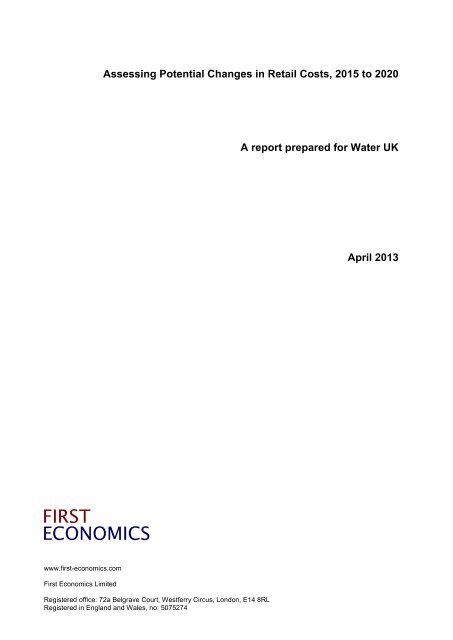

![Corporate social responsibility [CSR] has different ... - Water UK](https://img.yumpu.com/51398482/1/184x260/corporate-social-responsibility-csr-has-different-water-uk.jpg?quality=85)
